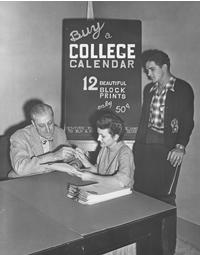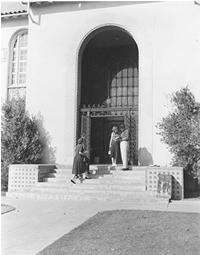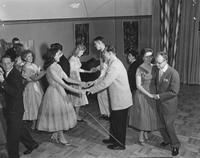1942-1958
The War Years, 1939-1945
The fall of France in 1940 and the passage and implementation of the Selective Service Act had a sobering effect on the campus. After the country's entry into the war, the number of male students on the campus decreased drastically. Total daytime enrollment dropped to less than 200 during the 1943-1944 year, with the vast majority of that number being women. In the spring of 1943, the contracts of seven instructors were terminated, and the following year four more were released.
Many of the male faculty went off to war. Eleven instructors were granted leave to enter military service, and two others were given leave to take war-related civilian jobs. The war affected the college in other direct ways, in both curriculum and campus activities. The vocational building, completed in the fall of 1941, was used to house a number of "Off Reservation Training" (ORT) courses. Courses in the repair of radio equipment and battery maintenance were also offered. During the first months of the war, rigid security regulations were imposed on those assigned in the ORT program. A stockade-like fence was constructed around the shop building, with armed sentries on guard. One of the more interesting assignments undertaken by the college during the war years were the teaching of English to Italian war prisoners at Camp Ono, north of San Bernardino.
The war also made itself felt in the regular academic courses. Classes were scheduled so that students could more easily graduate in a year and a half, including summer sessions, rather than in the normal two-year period. The nursing program increased its tempo to provide training of the Nurses' Cadet Corps in a 30-month period. Pre-induction courses in mathematics, physics, meteorology and astronomy were offered.
The war affected campus life in many other ways. Students promoted the sale of war stamps and bond drives. Receptacles were placed on the campus to deposit articles of clothing for the Red Cross and other war relief agencies, and to college scrap metal. A Red Cross workshop was set up in Science Building to teach students to fold bandages during their free periods. Knitting lessons were given for those who wanted to make apparel for those in the service.
In the last months of the war, after the defeat of Germany, the tempo subsided. The
first veterans were back on the campus as early as the fall of 1944, when a Veterans'
Club was organized. By the fall of 1945, the faculty men who had been on military
leave began to return, and veterans enrolled in the campus in ever-increasing numbers.
A big expansion in enrollment came a year later, in 1946, with the addition of many
new faculty members and a rapidly growing student body.
The Lounsbury Presidency, 1942-1958
Dr. Ricciardi resigned in March 1942 to accept a similar position at Sacramento Junior College. Dr. John B. Lounsbury, President of Long Beach City College, was appointed as Valley College's fourth president. The first four Lounsbury years were those in which war considerations were paramount. But beginning in 1946 and lasting for the remainder of his tenure, Valley College experienced a period of continuing growth and intense activity.
To accommodate the student population, it was necessary to schedule many classes in the late afternoon hours. War surplus buildings were also brought to the campus to provide additional offices, classrooms and space for student services.These buildings were located in the Quad to the east of the Administration Building, and some of them remained in use for many years.
A bond was passed in April 1946 to provide for the construction of an engineering building, a student center and a fine arts building, a new science building, a business education building, and an addition to the library.


Top priority was given to the construction of a large technical-engineering, home economics and music building. The contract was awarded in February 1949 and, except for the radio broadcasting area, the building (now North Hall) was ready for occupancy at the beginning of the fall 1950 semester. Construction of the Student Life Building did not begin until April 1954. The half-million dollar structure was completed about a year later. The old wooden Social Hall was then remodeled and moved to serve as an auxiliary gymnasium for the use of women students. In 1947, a clock was added to the Auditorium tower. It was a gift from John F. Vondey of Vondey Jewelers in San Bernardino.
In 1954, a carillon unit of Westminster chimes was presented by the Associated Student Body as a memorial to the more than one hundred Valley College students who lost their lives in World War II and the Korean conflict. Residential property to the north, south and east of the campus was purchased to convert into parking. Construction of a Chemistry Building began in late 1957.
Increased enrollment and a change in age and interest of the post-war students was reflected in changes in the curriculum. A larger percentage of students were interested in achieving immediate occupational goals, so additional courses in the business and technical fields were offered. An application to the Federal Communication Commission was made for a license to operate an FM station was made in early 1954, and when approved, station KVCR-FM came into being.
The political climate of the Cold War years was reflected in the activities of the college. All employees were required to take a loyalty oath, and applicants for teaching positions were questioned about their political beliefs. Trustees' relationships with the administration and the faculty were quite personal, with most teaching applicants meeting with one or more Board members before employment. Depending upon their training, interest or experience, each Board member assumed responsibility for a specific area: budget and finance, buildings, grounds, insurance or personnel. Citizen attendance at Board meetings was unusual, and most meetings were held in the Presidents office.

The campus was the center of social life for many students. Dances were held throughout the year, with big-name bands sometimes furnishing the music. Athletic events were well attended. Beginning in 1950, "College Nights," free to all ASB cardholders, were regularly scheduled. These events featured a full-length movie, followed by a dance, and ending at midnight with the closing of the student "Snack Shack."
A number of entertainers and political figures made campus appearances. A Bob Hope show, with Dorothy Lamour, Jerry Colonna, and Desi Arnaz and his orchestra, was broadcast from the Auditorium state in the spring of 1947. Edgar Bergen, with Charlie McCarthy, and Dinah Shore followed a year later. Senatorial candidates Richard Nixon and Helen Gahagan Douglas both appeared on campus during their 1950 election campaign, and Estes Kefauver stopped by to speak in 1955.
Enthusiasm and support for the college athletic programs reached their zenith during the Lounsbury years. This was especially true during the football season, when all student activities seemed to focus on the weekend game. The annual homecoming was a major event, with a bonfire rally, an alumni tea, a downtown parade, the selection of a homecoming queen and her court, a coronation ball, and the football game.
Two valuable unusual collections were given to the college during the Lounsbury years. In 1949, the Southwest Museum donated a collection of lantern slides of the American Southwest collected by George Wharton James, an early traveler and a friend and companion of such men as John Muir, Joseph LeConte, and Major John Wesley Powell. The collection remains in the custody of the Geology Department. In 1954, Wilson C. Hanna's collection of bird eggs was donated to the college, along with a contribution of $25,000 from the California Portland Cement Company for the construction of special display cases. This collection was eventually transferred to the San Bernardino County Museum.
President Lounsbury's last two years gave an indication of the changes that were in store for future administrations. A dispute over control over the "Fountain Room" was eventually resolved by the appointment of a committee that recommended minor changes that permitted a feeling of greater student involvement. A public dispute occurred during 1956-1957, when it was revealed that an engineering instructor from Turkey did not have the background to be credentialed.
In March of 1958, Dr. Lounsbury indicated his intention to retire at the end of the
academic year. During his sixteen years as president, the student body had grown from
one of less than 200 to one of nearly 2,000 day and 4,500 evening students. Two major
buildings had been added to the campus and a new construction program was underway.

